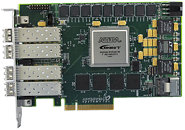Monday, March 26th 2012
AdvancedIO Debuts the Fastest Accelerating Ethernet Card for Financial Services
AdvancedIO Systems will reveal at the Low Latency Summit in London its newest generation of 10GE network cards powered by Altera's 28 nm Stratix V FPGAs. The V5031 design pushes the performance limit of what technology can achieve today in a small form factor that fits most platforms deployed in financial markets.
"There is an insatiable demand for scalable processing density, lower latency, and ease of programming to offer creative financial services in a competitive environment," said Mohammad Darwish, chief executive officer at AdvancedIO Systems. "Our technology has been proven to accelerate processing along the trade path and ultimately increase profit margins for our financial customers. We are excited about the possibilities.""AdvancedIO's application-centric approach to providing real-time low latency solutions for the financial markets coupled with Altera's latest 28-nm industry-leading FPGA technology is an impressive combination," said Jeff Waters, senior vice president and general manager of Altera's military, industrial and computer business unit. "We are pleased to work with AdvancedIO to deliver solutions that enable low latency trading and accelerate trading algorithms."
The V5031 is the fifth generation of our flagship programmable products featuring four 10GE optical ports, a scalable Stratix V FPGA, and advanced memory configurations. It is ideal for implementing trading strategies, risk controls, and a wide range of algorithms as close as possible to the network. To meet priority deadlines for rolling out new financial services, the expressXG development framework provides the standard toolset and debug capabilities required to work with our FPGA network cards. Experience the satisfaction of having all network, memory, and host interfaces functional right out of the box.
A production version of the V5031 network card will be on display in Altera's booth #112 at the Low Latency Summit in London on March 27, 2012. Join us at the 11am panel and hear us discuss how latency impacts system performance in financial systems.
For product information, please visit this page.
"There is an insatiable demand for scalable processing density, lower latency, and ease of programming to offer creative financial services in a competitive environment," said Mohammad Darwish, chief executive officer at AdvancedIO Systems. "Our technology has been proven to accelerate processing along the trade path and ultimately increase profit margins for our financial customers. We are excited about the possibilities.""AdvancedIO's application-centric approach to providing real-time low latency solutions for the financial markets coupled with Altera's latest 28-nm industry-leading FPGA technology is an impressive combination," said Jeff Waters, senior vice president and general manager of Altera's military, industrial and computer business unit. "We are pleased to work with AdvancedIO to deliver solutions that enable low latency trading and accelerate trading algorithms."
The V5031 is the fifth generation of our flagship programmable products featuring four 10GE optical ports, a scalable Stratix V FPGA, and advanced memory configurations. It is ideal for implementing trading strategies, risk controls, and a wide range of algorithms as close as possible to the network. To meet priority deadlines for rolling out new financial services, the expressXG development framework provides the standard toolset and debug capabilities required to work with our FPGA network cards. Experience the satisfaction of having all network, memory, and host interfaces functional right out of the box.
A production version of the V5031 network card will be on display in Altera's booth #112 at the Low Latency Summit in London on March 27, 2012. Join us at the 11am panel and hear us discuss how latency impacts system performance in financial systems.
For product information, please visit this page.

6 Comments on AdvancedIO Debuts the Fastest Accelerating Ethernet Card for Financial Services
Anyways my point is that I'm typically more impressed when copper is used rather than optical as you can push a ridiculous amount of data over a multi-mode fiber cable and honestly, if you can afford optical networking for your servers, I bet you can afford servers that won't bottleneck if work is offloaded to the CPU, but that isn't the point I was trying to make, and yes, it is better to have the CPU do less work on things like I/O.
And no matter what category cable you use, run limit will ALWAYS be 100m for ethernet, doesn't matters if there's xtalk or whatever, it's guaranteed to run at 10Gbit@100m@cat6a per the specification.
on the subject of the card, with the massive ammount of RAM in that board, i'm guessing this card is akin to the killer-NIC, it has a complete processing environment where customers can run specific latency-sensitive small "apps" maybe at fixed throughtput or fixed latency-per-transaction regardless of load. If done right it would be quite hard to get that performance on the server main cpu.
For example: you have a server with a DB engine and put the front-end app on the advancedIO NIC, which makes your CPU focus on the DB whislt the nic handles transactions, that means your server suddenly is a complete app platform without sacrificing performance by mixing/sharing the workload and you possibly don't need another server to act as front-end